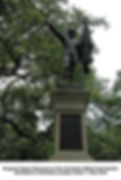
Any recounting of the life of the man who became Sgt. William Jasper, one of the most famous heroes of the Battle of Sullivan’s Island, must begin with the fact that very little is known about his early life. In fact, there are multiple versions of who he was and where he came from. Many historians suggest he was of Irish descent, born in 1750 in the American Colonies. His entry in the South Carolina Hall of Fame states he was probably born near Georgetown, South Carolina. Yet another version of Jasper’s origins suggests he was the son of John Jasper, a Virginia blacksmith who moved to Union County, South Carolina in the 1770’s.
Still others propose that he emigrated from Germany under the name Johann Wilhelm Gasper. One compelling theory posits that he arrived in America aboard the ship Minerva in 1767, landing in Philadelphia. Upon his arrival, Jasper, reportedly struggling with literacy, signed his name with an “X” when taking an oath of allegiance, while possibly a clerk or another emigrant helpfully Anglicized his name to William Jasper. This version then has Jasper ultimately moving to Georgia. Like many European immigrants of the time, he may have served a period of indentured servitude before making his way south in search of land and opportunity.
Wherever the truth lies, by the time tensions escalated between the American Colonists and Great Britain, Jasper had made his home in the South, possibly Georgia or South Carolina. Some accounts indicate his decision to enlist in the military may have been motivated by personal circumstances, including the need to secure enough financial stability to bring his fiancée from Pennsylvania to join him.
On July 7, 1775, in Halifax District of Georgia near Augusta, Jasper enlisted in the elite grenadier company of the Second South Carolina Regiment (Infantry), joining the fight for independence. His leadership abilities were recognized in his promotion to the rank of sergeant. As a grenadier, he would have participated in the seizure of Fort Johnson where Col. William Moultrie’s regimental flag was first raised. Although his early military career was unremarkable, fate soon placed him in a position to demonstrate extraordinary courage on the battlefield.

The defining moment of Jasper’s military career came on June 28, 1776, during the Battle of Sullivan’s Island. British forces launched a fierce assault against the fort made of palmetto logs and beach sand, hoping to capture Charlestown. During the intense bombardment, an enemy cannon ball struck the fort, cutting down its flag, a symbol of Patriot resistance.

Accounts vary as to the details of William Jasper’s actions that followed. Perhaps the most illustrative comes from historian Terry Lipscomb: “When the action began a tall flagstaff, which had once been the mast of a ship, stood on the rampart of the southeast bastion in the angle formed by its southern flank and face. Soon damage from enemy fire knocked the staff over the wall and onto the beach, and the fear arose that friend and foe alike might think the garrison had struck its colors to prepare for surrender. ‘Colonel, don’t let us fight without our flag!’ called Jasper, a grenadier sergeant stationed on the opposite side of the fort. ‘How can you help it?’ Moultrie answered.
‘The staff is gone.’ Jasper shouted in reply that he would fasten the color to a makeshift staff and raise it on the salient angle of the bastion where it would be visible to all. The sergeant leaped through an embrasure, walked the length of the fort through enemy fire, and cut the flag from the mast. He then mounted the outside wall, called to Capt. Peter Horry for help, tied the flag with a cord to a sponge staff provided by Horry’s gun crew, and planted it firmly in the sand on top of the rampart. That done, he gave three cheers and returned to his post.” Interestingly, if this description is accurate, many of the famous images of Jasper’s act are incorrect in showing a portion of the original flagpole tied to the sponge staff rather than just the flag.
Whatever the facts, the fame of Sgt. Jasper had begun. His fearless act boosted morale among the American troops and demonstrated the tenacity of the Revolutionary forces. John Rutledge, the chief executive of South Carolina, recognized Jasper’s heroism, and later awarded him his personal sword. He also offered him an officer’s commission. Jasper, ever humble, declined the promotion, feeling that his illiteracy would be an embarrassment to the officer corps, and choosing instead to continue serving as a noncommissioned officer.
Following the battle, Jasper continued his service in the war, engaging in guerrilla-style raids against British and Loyalist forces. His ability to navigate the terrain and execute surprise assaults made him a formidable adversary. He participated in numerous skirmishes across South Carolina and Georgia, targeting British supply lines and disrupting their control over the region.
Jasper also played a role in recruiting soldiers to the Patriot cause. His fame as a war hero made him an inspiring figure, and many Southern colonists were motivated by his fearless actions. Whether through direct recruitment or by setting an example of courage on the battlefield, Jasper influenced enlistment efforts and helped strengthen the American forces.
Jasper’s final act of heroism came during the Siege of Savannah on October 9, 1779, where American and French forces attempted to reclaim the city from British control. As the battle raged, Jasper was mortally wounded while rescuing his regiment’s flag and rallying the troops. Despite his injuries, he managed to retain the flag during the retreat and succumbed to his wounds shortly thereafter.
His sacrifice cemented his place as one of the great heroes of the American Revolution. His name became a rallying cry for Patriot forces, and his legacy continued to inspire future generations.
After Jasper’s death, his wife, Mary Wheatley Jasper, was left to care for their children, including twins Eliza and William, born in 1777. Mary later married Christopher Wagner, and the family remained in South Carolina. Eliza Jasper apparently married a man named Brown, though nothing else is known about him. She would later apply for a pension based on her famous father’s military service, a reflection of the struggles faced by Revolutionary War families in securing financial stability. By 1836, Eliza Jasper Brown was asking for assistance from the Charleston Poor House. After her request to the U.S. Congress for a pension was denied, it was only through the combined efforts of private citizens and the South Carolina legislature that the impoverished daughter of one of the most famous heroes of the American Revolution at age 74 was finally granted financial assistance in late 1844. That appears to have been a short-lived comfort, for the name Eliza Jasper Brown disappeared from the public record in 1845.
Jasper’s legacy endured long after his death. Counties, towns, and military units were named in his honor, ensuring his contributions to the war remained widely recognized. His story became a symbol of patriotism, illustrating the sacrifice and bravery required to secure American independence. Today graceful monuments stand in both Charleston and Savannah as memorials to the soldier history remembers as Sgt. William Jasper.


For more information about Sgt. William Jasper see:
Buchanan, John. The Road to Guilford Courthouse. New York: Wiley, 1997.
Edgar, Walter. South Carolina: A History. Columbia: University of South Carolina Press, 1998.
Butler, Nic. A Veteran’s Story: Caring for the Family of Sergeant William Jasper. Charleston Time Machine Podcast, Episode 134, November 8th, 2019.
Lipscomb, Terry W. The Carolina Lowcountry April 1775 – June 1776. South Carolina Revolutionary War Battles I, South Carolina Department of Archives and History, 2nd Ed. 1994.
The Friends of the Charleston National Parks endeavors to present informative and accurate materials for our readers. The subjects we cover are open to various interpretations and we invite readers to share their concerns about the material presented here. Please email us at Info@FCNP.org if you believe we have not correctly or accurately interpreted the historical record.






